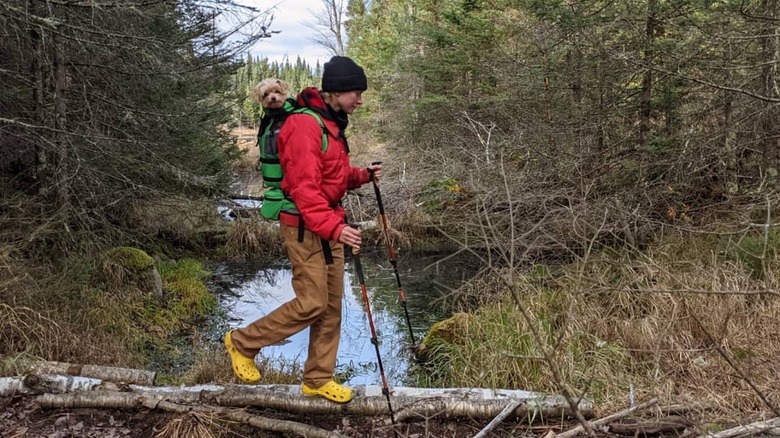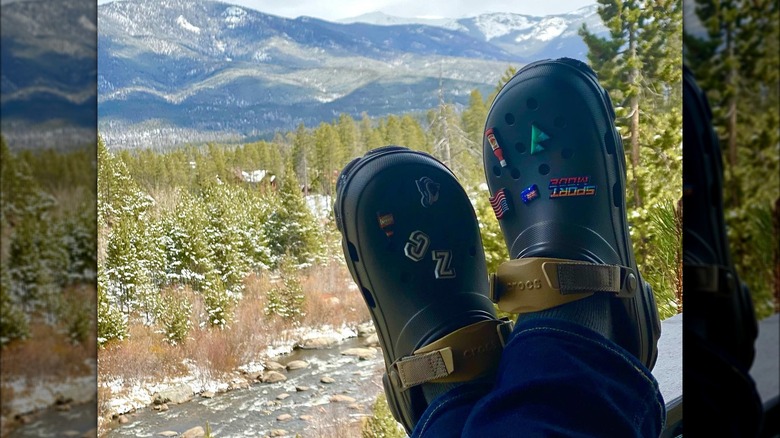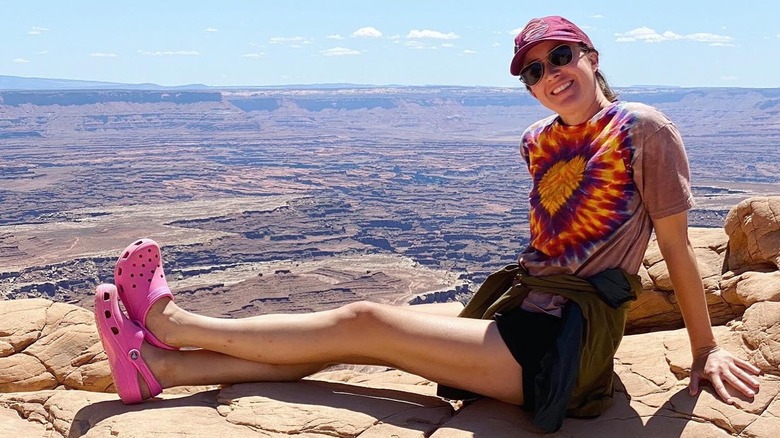Should You Be Hiking In Crocs?
We may receive a commission on purchases made from links.
Your hiking buddies laugh at you for strapping a pair of bright yellow Crocs to the outside of your ultralight pack as you head out for a weekend backpacking trip, but after you slip them on for a knee-deep river crossing, you're the only one whose feet aren't pruning up inside soggy shoes. And how nice does it feel at the end of the 12-mile day, padding around camp on those foamy little clouds of cush? When the stitching on your $200 trail runners soon starts to give you a hot spot, you swap them out for the Crocs and finish the day's hike in them — no harm, no foul, no blister. You start to wonder; maybe I should just go ahead and hike in Crocs all the time.
You wouldn't be the first to do so. It's a controversial practice, and thru-hikers on routes like the Pacific Crest Trail or Appalachian Trail disagree heatedly about whether it's a good idea or not. However, some hikers seem to be keeping their camp Crocs on for more and more miles, often after accidentally discovering how functional they are after a blister developed in their "real" shoes. Reddit is full of apocryphal, anecdotal trail tales of thru-hikers laying down hundreds of miles in Crocs, while one enthusiastic YouTuber claims to have hiked 6,000 miles in them. "I've worn them on probably a couple hundred miles of hiking over terrain ranging from flat to highly technical mountain terrain to downhill technical trail running (I've got video proof and plan to get more haha) and I love them," another avid convert writes on Reddit. "They are my favorite hiking shoes I've ever owned."
Which Crocs are the best to hike in?
Which style of Croc is best for hiking? There is, of course, the original unisex Crocs Classic Clog, favored by hikers who view their Crocs as primarily camp shoes that are also handy for river crossings (some even recommend skipping the brand name and going for the Walmart knock-offs, which weigh a little less). However, some hikers do put miles on these. You might have even seen the viral YouTube video of a Nepalese Sherpa hiking to Everest Basecamp at 16,400 feet in a pair, as if it were no big deal at all.
A newer model intended for rugged terrain is the All Terrain Clog (pictured), which has an adjustable heel strap to give you a more secure fit and a heavier, stiffer sole for traction. Depending on your hiking philosophy, though, heavier isn't necessarily better. If you think it is, chances are you're a traditionalist who prefers real leather hiking boots. Interestingly, though, just 2.4% of the class of 2023 who hiked the Pacific Crest Trail wore traditional hiking boots, while over 90% wore trail runners: The Altra Lone Peak trail runner was the most popular shoe on the PCT seven years running, according to Almost Anywhere's 2023 Pacific Crest Trail Thru-Hiker Survey.
The mold-breaking Altra was controversial when it launched in 2011, as it featured a zero drop from heel to toe and a wide toe box to allow your digits to splay naturally. Some thought them funny-looking, but the ergonomics of this design would not be denied. Crocs are controversial now, too, but no more so than the "barefoot running" shoes like the Vibram Five Fingers "toe shoes," which a small minority of hikers also swear by.
How to hike in Crocs, and why you might want to
The first thing you want to do when hiking in Crocs is put them into "sport mode" or "4WD" (as in 4-wheel-drive). That means flipping the heel strap down to actually go around your heel (pictured) instead of wearing it over the upper, leaving the back of the shoe open, clog-style. If you're still worried about the weight of carrying a spare pair — maybe you're an ultralighter who wears bread bags over socks as camp shoes, you might be tempted to cut the heel strap off, which is fine for camp shoes but not a good idea for hiking. However, since they're made of foam, you can take a blade to your Crocs and cut some pieces out of the upper or enlarge the drainage holes to save some weight.
There is one more seldom-discussed reason why wearing Crocs around camp and even for part of your hiking day could be particularly beneficial while backpacking — to give the foam midsoles of your trail runners a chance to rebound. Elite runners always alternate training days between at least two pairs of shoes to give the foam a rest after the compression of a training session. One study by the Scandinavian Journal of Medicine and Science in Sports even showed that springier, well-rested shoes produced fewer sport-related injuries. Having a lightweight spare pair of shoes might just help you be more comfortable and stay injury-free on a long backpacking trip. You may not be ready to entirely surrender your trail runners, but as a spare pair and handy backup, a pair of Crocs might just be a great addition to your budget-conscious hiking gear list.


